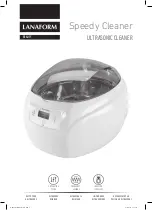
To obtain the best results with the 3C:
The engine temperature should be “cold” (ambient temperature) to warm
before the cleaning process begins. If the engine is hot the results will not
be optimal. Engines with high mileage or heavy carbon deposits will need
to be cleaned twice. If the ambient air temperature is greater than 60°F or
if the engine is hot: refrigerate the 3C Chemical and allow the chemical to
fully cool before use.
Testing the catalytic converter efficiency:
At this time it is a good idea and recommended that you check the catalytic
converter. This is accomplished by selecting the front and rear O2 or WRAF
sensors with the scan tool in graph mode or use the ESCAN
TM
catalytic
converter efficiency test. If the rear O2 sensor is oscillating (moving up and
down) under a light steady load; the catalytic converter is bad. Do not assume
that this will set a code! Many vehicles, such as Toyota, have an aging program
where the catalytic converter is not checked until the codes are cleared. If the
catalytic converter is not checked this means the Mode 6 data is not updated
therefore unusable. The only correct way to check the catalytic converter is to
drive the vehicle and use the data PID’s for the O2 and/or WRAF. During our
4 years of development of the 3C cleaner, hundreds of vehicles were cleaned
and no spark plug was ever fouled, no catalytic converter was ever damaged.
If the catalytic converter is bad before cleaning it will be bad after cleaning. If
the catalytic converter is good before cleaning the catalytic converter
efficiency will increase by 10 to 20 percent.
The 3C was designed to limit the carbon accumulation in the gasoline based engine. The recommended
maintenance cleaning on a Gasoline Direct Injected (GDI) engine is every 30,000 miles. Some GDI engines
will have heavy carbon accumulations with less mileage and will need to be cleaned more frequently.
NOTE: cleaning results will vary in high mileage engines that have not had regular cleanings.
The carbon
deposit itself will be different from engine to engine depending on; the type of oil used, the loads placed on
the engine, and the number of heat cycles the engine has been through.
Check engine lamp:
If the check engine lamp is on: pull and record the Diagnostic Trouble Codes (DTC).
















